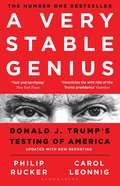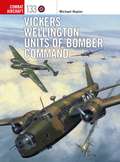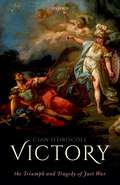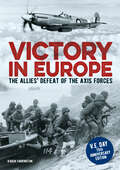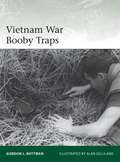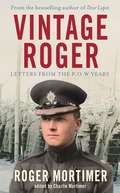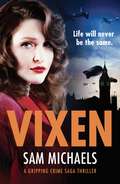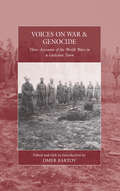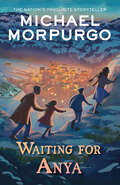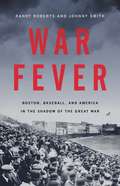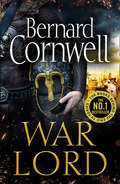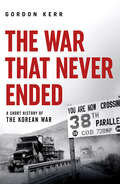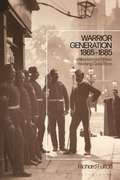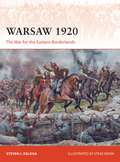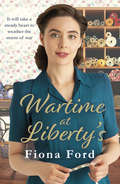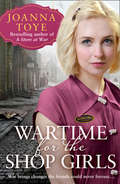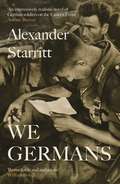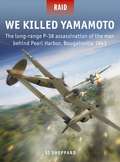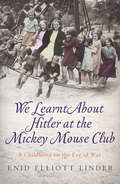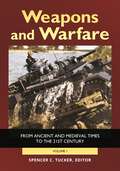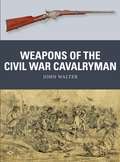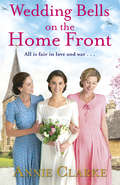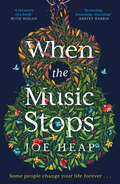- Table View
- List View
A Very Stable Genius: Donald J. Trump's Testing of America
by Philip Rucker Carol D. Leonnig'In often alarming detail, A Very Stable Genius chronicles the wild ride of the Trump presidency' Guardian'Taut and terrifying . . . It reads like a horror story, an almost comic immorality tale . . . It's as if the president, as patient zero, had bitten an aide and slowly, bite by bite, an entire nation had lost its wits and its compass' New York Times'Takes us behind the scenes of the Trump presidency, where we learn that the private Trump is – if you can believe it – even worse than what you see every day' Washington PostThe definitive insider narrative and the most fully characterised account yet of the chaos, scandal and destruction of Trump's first term, from two Pulitzer Prize-winning Washington Post journalists.Drawing on nearly three years of reporting, hundreds of hours of interviews and more than two hundred sources, including some of the most senior members of the administration, friends and first-hand witnesses who have never spoken before, Philip Rucker and Carol Leonnig take us inside some of the most controversial moments of Trump's presidency. They peer deeply into Trump's White House – at the aides pressured to lie to the public, the lawyers scrambling to clear up norm-breaking disasters, and the staffers whose careers have been reduced to ashes – to paint an unparalleled group portrait of an administration driven by self-preservation and paranoia. Rucker and Leonnig reveal Trump at his most unvarnished, showing the unhinged decision-making and incompetence that has floored officials and stunned foreign leaders. They portray unscripted calls with Vladimir Putin, steak dinners with Kim Jong-un, and calls with Theresa May so hostile that they left her aides shaken. They also take a hard look at Robert Mueller, Trump's greatest antagonist to date, and how his investigation slowly unravelled an administration whose universal value is loyalty – not to country, but to the president himself.Grippingly told, A Very Stable Genius is a behind-the-scenes account of Trump's vainglorious pursuit of power in his first term – the rages and the frenzies, the dishonesty and the depravity – as his remaining loyal staffers eye the exits, and he stares down the reality of impeachment.
Vickers Wellington Units of Bomber Command (Combat Aircraft #133)
by Michael NapierThe Vickers Wellington was one of very few aircraft types to have been in production and frontline service throughout World War II, and more than 10,000 Wellingtons were built in the period. They took part in the first RAF bombing mission of the conflict when, on 4 September 1939, 14 examples from Nos 9 and 149 Sqns undertook a daring daylight attack on the Kiel Canal. However, after suffering high losses on follow-up raids, Wellingtons were withdrawn from daytime missions and began to operate at night from May 1940. They subsequently took part in raids against the Italian port city of Genoa in July 1940, and against Berlin the following month, followed by key missions in the 'Battle of the Barges' in September and October, as the RAF targeted the Germany's invasion fleet being assembled in French Channel ports. When RAF's strike force expanded the next year following the introduction of the improved Wellington II, the 21 squadrons equipped with the Vickers aircraft, which included Polish-, Canadian- and Australian-manned units, formed the backbone of the Bomber Command night bombing force. Over the next two years Wellingtons participated in all the major operations by Bomber Command, including the daylight raid against German battleships in Brest harbour in July 1942 and the first three 'Thousand Bomber' raids in the summer of 1942.This illustrated study explores the design, development, and deployment of the Vickers-Wellington type, charting its role in World War II from its earliest missions to its use in training after its withdrawal from frontline bomber missions in 1943. The text is supported by stunning full-colour artwork.
Victory: The Triumph and Tragedy of Just War
by Cian O'DriscollCommitting one's country to war is a grave decision. Governments often have to make tough calls, but none are quite so painful as those that involve sending soldiers into harm's way, to kill and be killed. The idea of 'just war' informs how we approach and reflect on these decisions. It signifies the belief that while war is always a wretched enterprise it may in certain circumstances, and subject to certain restrictions, be justified. Boasting a long history that is usually traced back to the sunset of the Roman Empire, it has coalesced over time into a series of principles and moral categories—e.g., just cause, last resort, proportionality, etc.—that will be familiar to anyone who has ever entered a discussion about the rights and wrongs of war. Victory: The Triumph and Tragedy of Just War focuses both on how this particular tradition of thought has evolved over time and how it has informed the practice of states and the legal architecture of international society. This book examines the vexed position that the concept of victory occupies within this framework.
Victory in Europe: The Allies' Defeat of the Axis Forces
by Karen FarringtonOperation Overlord was one of the greatest ever military offensives, working to free Europe from the yoke of Nazism. Starting with the landings on D-Day, Victory in Europe traces the Allied struggle to create a foothold in "Fortress Europe". Overcoming initial setbacks, the final crossing of the Rhine and the advance into Germany changed the course of European history forever. This gripping story is told from the perspective of the service men at the centre of the operation, and how their bravery and doggedness made the defeat of Hitler's hordes possible.Illustrated with over 100 black and white photos and maps, Victory in Europe is a thrilling read on the final offensive push against Adolf Hitler.Features:• Normandy landings• The liberation of Paris• Battle of the Bulge• The fall of Berlin• VE Day
Vietnam War Booby Traps (Elite #236)
by Gordon L. RottmanDuring the Vietnam War, the Viet Cong were frequently unable to hold their own in stand-up fights against US and allied forces who were superior in strength, firepower, mobility, and logistics. They relied instead on traditional guerrilla warfare tactics including small-scale hit- and-run attacks, ambushes, terrorist actions, and precision attacks against bases. These included one of the oldest of guerrilla weapons – the boobytrap. Booby traps could be made in large numbers in village workshops and jungle camps using locally available materials as well as modern munitions. The VC were adept at making booby traps 'invisible' in the varied terrain of Vietnam, often emplacing them in locations and surroundings totally unexpected by their enemies. Booby traps could be incredibly simple or startlingly complex and ingenious, ranging from pointed sticks to command-detonated submerged floating river mines. Besides a wide variety of booby traps, they also used land and water mines, both contact/pressure-detonated and command-detonated. Between January 1965 and June 1970 11 percent of US troop deaths in action and 17 percent of injuries were by caused booby traps and mines. This fascinating title explores not only the wide variety of booby traps employed by the Viet Cong, but also their various uses in halting, stalling, or locating an enemy, and the many evolutions these traps underwent in order to retain the element of surprise. Written by a Vietnam veteran with first-hand experience of such traps, this is an engaging look at one of the most frightening aspects of guerrilla warfare.
Vintage Roger: Letters from the POW Years
by Roger Mortimer'I think prison has done me very little harm and some good. I am now far better read, far less smug and conceited, far more tolerant and considerably more capable of looking after myself.'In 1930, 21-year-old Roger Mortimer was commissioned into the 3rd Battalion Coldstream Guards, and would spend the next eight years stationed at Chelsea Barracks. He lived a fairly leisurely existence, with his parents' house in Cadogan Gardens a stone's throw away, and pleasant afternoons were whiled away at the racecourse or a members' club - officers in the battalion were even allocated 'soldier servants'. Admittedly things got a little hairy in Palestine in 1938, when Roger, now a captain, found himself amidst the action in the Arab Uprising. The worst, however, was yet to come. While fighting the Germans in 1940, Roger was knocked unconscious by a shell explosion - he was then incorrectly reported to have been killed in action. Upon waking he was delighted to find that he had survived. Though he was somewhat less delighted to find that he was now a Prisoner of War. Thus began a period of incarceration that would last five long years, and which for Roger there seemed no conceivable end in sight. Vintage Roger is Roger Mortimer at his witty, irreverent best. Exuding the charm and good humour that captured the nation's hearts in Dear Lupin and Dear Lumpy, this uplifting account tells of Roger's years in the Coldstream Guards and is followed by a collection of letters he wrote to his good friend Peggy Dunne from May 1940 to late 1944. Steadfastly optimistic and utterly captivating, the letters paint a vivid portrait of life as a POW.
Vixen: a gripping crime thriller (Georgina Garrett Series #3)
by Sam MichaelsWhile World War Two rages on around them, the gangs of London are fighting for their turf... There might be a war on, but that doesn't stop Georgina Garrett running her business with an iron fist. No one said running the Battersea gang was going to be easy, but her unflinchable nature makes Georgina unstoppable. With a role that requires a ruthless ability to seek revenge and pay out crippling punishments, Georgina's enemies are growing in number. With a target on her back, Georgina knows she must do everything to protect her family. But, with the loss of someone closest to her, can Georgina rise up from the ashes or allow a usurper take her crown? Perfect for fans of Peaky Blinders, Martina Cole and Lesley Pearse.
Voices on War and Genocide: Three Accounts of the World Wars in a Galician Town (War and Genocide #30)
by Omer BartovTaking as its point of departure Omer Bartov’s acclaimed Anatomy of a Genocide, this volume brings together previously unknown accounts by three individuals from Buczacz. These rare narratives give personal glimpses into daily life in unsettled times: a Polish headmaster during World War I, a Ukrainian teacher and witness to both Soviet and German rule, and a Jewish radio technician, genocide survivor, and member of the Polish resistance. Together, they offer a prismatic perspective on a world remote from our own that nonetheless helps us understand how people not unlike ourselves responded to mass violence and destruction.
Waiting for Anya
by Michael MorpurgoA gripping World War II adventure from War Horse author and former Children's Laureate, Michael Morpurgo. Jo did not stop until he’d shut the door behind him and even then his heart could not stop pounding in his ears.
War Fever: Boston, Baseball, and America in the Shadow of the Great War
by Randy Roberts Johnny SmithA "richly detailed" portrait of the three men whose lives were forever changed by WWI-era Boston (Michael S. Neiberg): baseball star Babe Ruth, symphony conductor Karl Muck, and Harvard Law student Charles Whittlesey.In the fall of 1918, a fever gripped Boston. The streets emptied as paranoia about the deadly Spanish flu spread. Newspapermen and vigilante investigators aggressively sought to discredit anyone who looked or sounded German. And as the war raged on, the enemy seemed to be lurking everywhere: prowling in submarines off the coast of Cape Cod, arriving on passenger ships in the harbor, or disguised as the radical lecturing workers about the injustice of a sixty-hour workweek.War Fever explores this delirious moment in American history through the stories of three men: Karl Muck, the German conductor of the Boston Symphony Orchestra, accused of being an enemy spy; Charles Whittlesey, a Harvard law graduate who became an unlikely hero in Europe; and the most famous baseball player of all time, Babe Ruth, poised to revolutionize the game he loved. Together, they offer a gripping narrative of America at war and American culture in upheaval.
War Lord (The Last Kingdom Series #13)
by Bernard CornwellIN THE FINAL RECKONING, CHOOSE YOUR SIDE CAREFULLY… The epic conclusion to the globally bestselling historical series.
The War That Never Ended: A Short History of the Korean War
by Gordon KerrThe Korean War of 1950-1953 ended in a frustrating stalemate, the echoes of which reverberate to this day. It was the only conflict of the Cold War in which forces of major nations of the two opposing systems - capitalism and communism - confronted each other on the battlefield. And yet, in the sixty years since it was fought it has been strangely neglected, perhaps because no one was able to claim the victor's spoils. A Short History of the Korean War details the origins, battles, politics and personalities of the war that never ended.Praise for Gordon Kerr'Informative, fascinating and extremely well-researched...Gordon Kerr's book is a mini masterpiece' - Rob Minshull, ABC Brisbane on A Short History of the Vietnam War'Factual and even-handed, Kerr presents a fair-minded introduction of basic Chinese history' - Booklist on A Short History of China
Warrior Generation 1865-1885: Militarism and British Working Class Boys
by Richard FultonRichard Fulton's Warrior Generation 1865-1885 fundamentally rethinks the efficacy of an institutional drive among influential middle-class opinion leaders to militarize lower-class boys in Victorian Britain. He contends that instead of engendering the desired cultural militarism, as has been commonly argued, their push had merely contributed to a fast-developing culture of adventure and masculinity.Challenging this popular assumption, Fulton carefully reexamines many of the oft cited touchstones of militaristic influence on lower-class boys, deeply assessing their actual effects on the behaviours and cultural practices of this generation. He explores a range of themes from, among others, the propagation of the military's message in school curricula (and its glorification in students' textbooks), to the military's heroic depiction and ubiquitous presence in lower-class boys' entertainment and popular media.
Warsaw 1920: The War for the Eastern Borderlands (Campaign #349)
by Steven J. ZalogaThe Battle of Warsaw in August 1920 has been described as one of the decisive battles of European history. At the start of the battle, the Red Army appeared to be on the verge of advancing through Poland into Germany to expand the Soviet revolution. Had the war spread into Germany, another great European war would have ensued, dragging in France and Britain. However, the Red Army was defeated by 'the miracle on the Vistula'. This campaign title explores the origins and outcomes of this momentous battle. In May 1920, the Polish Army intervened in war-torn Ukraine, pushing all the way to Kiev, but the Red Army, by now triumphant in most of the theatres of the Russian Civil War, turned its attention to this new threat. By the late summer of 1920, two Soviet armies had advanced into Poland and the overconfident Soviet leadership dreamed of advancing over a prostrate Polish Army into neighbouring Germany to ignite a Communist revolution in the heart of Europe.Thanks to the low density of forces on both sides and the huge distances involved, the conflict was a war of manoeuvre, with a curious mixture of traditional and advanced tactics. Horse cavalry played a dominant role in the fighting, but aeroplanes, tanks, and armoured trains lent the war an air of modernity. This illustrated study explores the war through the lens of the Battle of Warsaw, the turning point when, after a summer of disastrous retreat, the Polish army rallied and repulsed the Red Army at Warsaw and Lwow.
Wartime at Liberty's
by Fiona FordLondon, 1942Flo Canning’s heart is beyond repair following the news that she has been dreading since the outbreak of war. As Flo throws herself into the role of fabric manager at Liberty’s, old and new friends alike help pull her from a whirl of despair. Between work and home life there’s plenty to keep Flo occupied. Not least new deputy store manager, Henry Masters, whose arrival has consequences that Flo and her workmates could never have foreseen.But there is more tragedy still to come, and Flo and her friends will need each other more than ever if they are to survive the uncertainty ahead.
Wartime for the Shop Girls (The Shop Girls #2)
by Joanna ToyeWar brings changes the friends could never foresee… ‘Cheerful and uplifting… I enjoyed it immensely’ Katie Fforde ‘Highly recommended’ Anna Jacobs
We Germans
by Alexander StarrittWhen a young British man asks his German grandfather what it was like to fight on the wrong side of the war, the question is initially met with irritation and silence. But after the old man's death, a long letter to his grandson is found among his things. That letter is this book. In it, he relates the experiences of an unlikely few days on the Eastern Front - at a moment when he knows not only that Germany is going to lose the war, but that it deserves to. He writes about his everyday experience amid horror, confusion and great bravery, and he asks himself what responsibility he bears for the circumstances he found himself in. As he tries to find an answer he can live with, we hear from his grandson what kind of man he became in the seventy years after the war.We Germans is a fundamentally human novel that grapples with the most profound of questions about guilt, shame and responsibility - questions that remain as live today as they have always been.
We Killed Yamamoto: The long-range P-38 assassination of the man behind Pearl Harbor, Bougainville 1943 (Raid #53)
by Si SheppardHe masterminded the most devastating surprise attack against the United States in its history. He was a marked man in the war that followed. A key intelligence breakthrough enabled the military to pinpoint his location. An elite team was assembled and charged not with his capture and subsequent trial but with his execution. Osama bin Laden? No – this was Admiral Isoroku Yamamoto, the Commander-in-Chief of the Japanese Combined Fleet during World War II. This new title analyses the origins, implementation, and outcomes of Operation Vengeance, the long-range fighter interception of Admiral Yamamoto's transport aircraft that sent him to his death on 18th April, 1943. Author Si Sheppard examines every angle of the operation in detail, including the role of intelligence work in pinpointing the time and location of Yamamoto's flight, the chain of command at the highest level of the US political and military establishment who ordered the attack, and the technical limitations that had to be overcome in planning and conducting the raid. It also provides a close study of the aerial combat involved in completing the mission, offering a holistic exploration of the operation which avenged Pearl Harbor.
We Learnt About Hitler at the Mickey Mouse Club: A Childhood on the Eve of War
by Enid Elliott LinderEnid Elliot Linder was the daughter of a butler and a lady’s maid in service in some of England’s grandest country houses. Evoking the lost world of a childhood ‘below stairs’, Linder’s touching memoir describes how her life changed as Britain headed towards war. After the family moved to a Marylebone tenement, her father sought work in London restaurants whilst battling personal demons. Meanwhile Linder’s aunt was nanny to a high-ranking member of the British Union of Fascists as they grew in influence. In a photorealistic and immensely charming narrative reminiscent of Patrick Hamilton, Linder evokes the sights and smells of prewar London - and of lonely Cornwall, to where she was unhappily evacuated - in a way that will appeal to fans of Call The Midwife or Downton Abbey. A unique personal account of a tumultuous time.
Weapons and Warfare [2 volumes]: From Ancient and Medieval Times to the 21st Century [2 volumes]
by Spencer C. TuckerThis work covers major weapons throughout human history, beginning with clubs and maces; through crossbows, swords, and gunpowder; up to the hypersonic railgun, lasers, and robotic weapons under development today.Weapons and Warfare is designed to provide students with a comprehensive and highly informative overview of weapons and their impact on the course of human history. In addition to providing basic factual information, this encyclopedia will delve into the greater historical context and significance of each weapon. The chronological organization by time period will enable readers to fully understand the evolution of weapons throughout history.The work begins with a foreword by a top scholar and a detailed introductory essay by the editor that provides an illuminating historical overview of weapons. It then offers entries on more than 650 individual weapons systems. Each entry has sources for further reading. The weapons are presented alphabetically within six time periods, ranging from the prehistoric and ancient periods to the contemporary period. Each period has its own introduction that treats the major trends occurring in that era. In addition, 50 sidebars offer fascinating facts on various weapons. Numerous illustrations throughout the text are also included.
Weapons of the Civil War Cavalryman (Weapon #75)
by John WalterDuring the American Civil War, the mounted soldiers fighting on both sides of the conflict carried a wide array of weapons, from sabers and lances to carbines, revolvers, and other firearms. Though some sections of the cavalry placed their trust in the sabre, the advent of viable breechloading carbines -- especially repeaters such as the Spencer -- was to transform warfare within little more than a decade of General Lee's final surrender at Appomattox. However, output struggled to keep up with unprecedented demands on manufacturing technology and distribution in areas where communication was difficult and in states whose primary aim was to equip their own men rather than contribute to the arming of Federal or Confederate regiments. In addition, the almost unparalleled losses of men and equipment ensured that almost any firearm, effectual or not, was pressed into service. Consequently, the sheer variety of weaponry carried reflected the mounted soldiers' various roles in different theatres of operation, but also the availability -- or otherwise -- of weapons, notably on the Confederate side. Fully illustrated, this study assesses the effectiveness of the many different weapons arming the Civil War cavalryman and analyses the strengths and weaknesses of the decisions made after 1865 concerning the armament of the US cavalry.
Wedding Bells for Woolworths (Woolworths)
by Elaine EverestJuly 1947. Britain is still gripped by rationing, even as the excitement of Princess Elizabeth’s engagement sweeps the nation. In the Woolworths’ canteen, Freda is still dreaming of meeting her own Prince Charming. So far she’s been unlucky in love. When she has an accident on her motorbike, knocking a cyclist off his bicycle, it seems bad luck is still following her around. Anthony is not only a fellow Woolworths employee but was an Olympic hopeful. Will his injured leg heal in time for him to compete? Can he ever forgive Freda?Sarah's idyllic family life is under threat with worries about her husband, Alan. Does he still love her?The friends must rally round to face some of the toughest challenges of their lives together. And although they experience loss, hardship and shocks along the way, love is on the horizon for the Woolworths girls . . .Wedding Bells for Woolworths is the fifth instalment in Elaine Everest's much-loved Woolworths series.
Wedding Bells on the Home Front: A heart-warming story of courage, community and love (Factory Girls #3)
by Annie Clarke**THE THIRD NOVEL IN THE UPLIFTING FACTORY GIRLS SERIES** Perfect for fans of Nancy Revell's Shipyard Girls series and Ellie Dean. Our readers LOVE the Factory Girls . . .‘The characters are all strong and the style of writing makes it hard to put down’ ‘Another lovely story these wonderful characters make me feel like I’m visiting old friends’‘What a joy to read’‘I have laughed, cried and been angry reading this book’‘Another brilliant book’_____________________March 1942: As the war continues, wedding bells are ringing for the factory girls . . .Sarah is happily settling into married life with new husband Stan, whilst Fran is busy planning her upcoming wedding to sweetheart Davey, who’s still conscripted to Bletchley Park. With limited resources, the girls must make do to create the perfect day.Meanwhile, Beth has other things on her mind. She hasn’t heard from her husband Bob since he returned to the navy, and she’s starting to fear the worst. And new friend Viola is still recovering from a nasty accident.Life on the home front can be challenging, but with the support of one another, the factory girls can get through anything._____________________Praise for Annie Clarke 'Clarke’s tale is one to lift the spirits and touch the hardest hearts' Northern Echo 'Delightful authentic-feeling saga' Peterborough Telegraph 'Highlights the strength of women during the toughest times' Culture Fly 'Beautifully written' Frost Magazine
The West End Girls: a heartwarming WW1 saga about love and friendship (The West End Girls Book 1) (The West End Girls #1)
by Elaine Roberts'A fabulous, uplifting tale of friendship at the heart of wartime' Fiona Ford on Christmas at the Foyles Bookshop. 1914. Growing up on a farm in the country, Annie Cradwell has always dreamt of singing on stage. So when she hears her friend Joyce has a room to spare in London, she sets off with best friend Rose for an adventure beyond anything they could have imagined. In London, Annie and Rose stumble into jobs at the Lyceum Theatre. Being a dresser to capricious star Kitty Smythe wasn't exactly what Annie had in mind. But then the musical director, Matthew Harris, offers her singing lessons. And Annie starts to wonder – could this be her chance? Or is it all too good to be true? With the threat of war in the air, everything is uncertain. Is there a place for hopes and dreams when so much is at stake? Annie, Rose and Joyce are three girls with very different dreams – but the same great friendship. From the author of the beloved Foyles Bookshop Girls series, The West End Girls is the first in a brand new series full of Elaine Roberts' trademark warmth. Perfect for fans of Daisy Styles and Rosie Hendry.
When the Music Stops
by Joe Heap‘The sheer definition of a page-turner’ Reader review ‘A truly original, bittersweet tale of life, loss and enduring love that had me completely hooked. A treasure of a book!’ Sunday Times bestseller, Ruth Hogan
